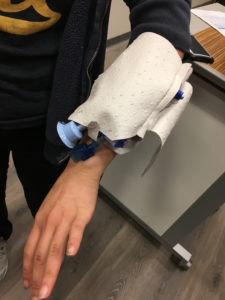On December 7th, four teams of UC Berkeley students pitched their designs for mobilizing and improving intravenous (IV) treatment in the OSAA Med Tech Collider.
The Collider — run by partnerships between the Sutardja Center, the Jacobs Institute for Design Innovation, and OSAA-Innovation — was created to improve the design of poles that hold bags of IV fluids for hospital patients. Currently, the poles are bulky and do not allow patients to move around very easily. Around 90% of all patients that are hospitalized receive IV treatment, with 92% stating that they didn’t find the pole user-friendly, and 75% citing mobility as the biggest issue.
The winning team, IV-GO, presented a carry-on, side-strapped IV bag designed for ease of wearability. The designers — Asher Saghian and Patrick Thelen — had India’s crowded hospitals in mind when building their product and hoped for their product to better conditions in hospitals in developing countries.

Team IV-GO, Asher Saghian and Patrick Thelen, showing off their prototype of an IV side-strapped solution
The runner-up team, X Queez-It, introduced the first wearable infusion device, a product that could be simply wrapped around a patient’s arm. The team — formed by Guolin Oo, Tiffany Chiang, and Maria Artunduaga — specifically looked at patients that were capable of working, moving and recovering at home rather than at the hospital, reducing medical costs by 30%.

Team X Queez-It’s prototype is a completely wearable infusion device that straps directly to a patient’s arm
Teams worked for 8-9 weeks and varied in product designs from detailed IV belts to arm wraps. During the pitch, products were judged based on technicality and feasibility, design concept and sustainability, partnerships and business propositions, and quality.
Most products had a manufacturing cost of around a nine to ten dollar range, and were projected to have a market from $200 million to $3 billion. Teams went through several iterations of designs, with a large issue being consistency and simplicity.
Over the course of the Collider, teams partnered closely with advisors from General Electric, UC Berkeley, Danish startup OSAA-Innovation, Jacobs, UCSF, and other organizations to create their products. Jes Broeng, founder of the Collider, praised advisor and later judge Michael ‘Moose’ O’Donnell for his support.
The Collider was started to help an early-stage European start-up to consider and explore American business and partnership possibilities. The European start-up later became OSAA-Innovation, and was founded during the Collider.
Presentation Download
Group 3 Presentation
IV Go presentation
moviliv presentation
X Queez-It Presentation
On December 7th, four teams of UC Berkeley students pitched their designs for mobilizing and improving intravenous (IV) treatment in the OSAA Med Tech Collider.
The Collider — run by partnerships between the Sutardja Center, the Jacobs Institute for Design Innovation, and OSAA-Innovation — was created to improve the design of poles that hold bags of IV fluids for hospital patients. Currently, the poles are bulky and do not allow patients to move around very easily. Around 90% of all patients that are hospitalized receive IV treatment, with 92% stating that they didn’t find the pole user-friendly, and 75% citing mobility as the biggest issue.
The winning team, IV-GO, presented a carry-on, side-strapped IV bag designed for ease of wearability. The designers — Asher Saghian and Patrick Thelen — had India’s crowded hospitals in mind when building their product and hoped for their product to better conditions in hospitals in developing countries.

Team IV-GO, Asher Saghian and Patrick Thelen, showing off their prototype of an IV side-strapped solution
The runner-up team, X Queez-It, introduced the first wearable infusion device, a product that could be simply wrapped around a patient’s arm. The team — formed by Guolin Oo, Tiffany Chiang, and Maria Artunduaga — specifically looked at patients that were capable of working, moving and recovering at home rather than at the hospital, reducing medical costs by 30%.

Team X Queez-It’s prototype is a completely wearable infusion device that straps directly to a patient’s arm
Teams worked for 8-9 weeks and varied in product designs from detailed IV belts to arm wraps. During the pitch, products were judged based on technicality and feasibility, design concept and sustainability, partnerships and business propositions, and quality.
Most products had a manufacturing cost of around a nine to ten dollar range, and were projected to have a market from $200 million to $3 billion. Teams went through several iterations of designs, with a large issue being consistency and simplicity.
Over the course of the Collider, teams partnered closely with advisors from General Electric, UC Berkeley, Danish startup OSAA-Innovation, Jacobs, UCSF, and other organizations to create their products. Jes Broeng, founder of the Collider, praised advisor and later judge Michael ‘Moose’ O’Donnell for his support.
The Collider was started to help an early-stage European start-up to consider and explore American business and partnership possibilities. The European start-up later became OSAA-Innovation, and was founded during the Collider.
Presentation Download
Group 3 Presentation
IV Go presentation
moviliv presentation
X Queez-It Presentation



